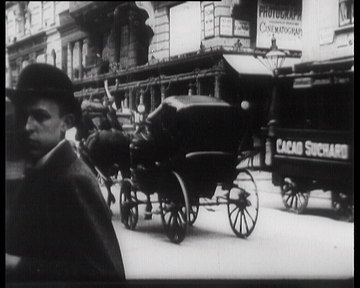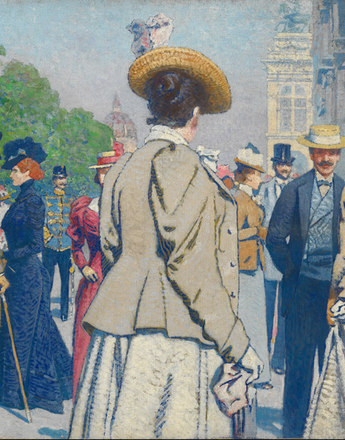The first cinematograph in Vienna – a medium takes Austria-Hungary by storm

Entrée du Cinématographe, film still, F 1896
Copyright: Filmarchiv Austria
Partner: Filmarchiv Austria
After the Lumière brothers had presented the cinematographic technology for the first time commercially on 28 December 1895 on Boulevard des Capucines in Paris, there were shows the following February in London, Bordeaux and Brussels. The ‘living photographs’ were presented in Vienna on 20 March 1896.
The first private showings of the ‘Cinématographe’ was held in the k. k. Graphische Lehr- und Versuchsanstalt. The public premiere took place on the same day at Kärtner Strasse 45/Krugerstrasse in the 1st district. For 50 kreuzer a non-stop programme of ‘living photographs’ was shown from 10 a.m. to 8 p.m. The highpoint of every performance was the film of a train gradually approaching the viewer. The scene was always accompanied by thunderous applause. By the end of 1896 the Lumière cinematograph had been shown in travelling exhibitions in all of the major cities in the Monarchy.
To increase interest in the cinematograph, films were made of local scenes and included by the showmen in their standard programmes. In this way the local population could see ‘real, living pictures’ of their own environment. In April 1896 the operator Alexander Promio and his assistant and interpreter Alexander Werschinger arrived in Vienna on commission from Société Lumière to film Viennese sights. Their subjects included St Stephan’s Cathedral, the Stadtpark, Türkenschanzpark, the Prater amusement park and Hauptallee, a Viennese fiacre, strolling passers-by, the Deutschmeister band, and the Giant Ferris Wheel. These films were shown to Emperor Franz Joseph in the Hofburg on 18 April 1896. Alexander Werschinger reported: ‘We had a small room on the second floor of the Burg, as the palace is known, which we were able to try out two days in advance. The entire presentation was to be limited to five minutes, as it was feared that the flickering pictures could damage His Majesty’s eyes. It was also very difficult to explain to the attendant that the demonstration had to be carried out in the dark. He said that this was not possible because court protocol demanded that two candles should always be lit in the presence of His Majesty. Everyone was amazed that after he had seen the pictures, the Emperor demanded very animatedly that they be shown again twice and then conversed with us for several minutes in fluent French.’
Further films were made shortly afterwards of the fire brigade am Hof, the harnessing of a horse, Kärntnerstrasse, the saddle room at Freudenau after the Pisek race, and the entrance to the cinematograph. This last film, entitled Entrée du Cinématographe, has survived and shows the site of the first cinematographic performances in Vienna at Kärtnerstrasse 45/Krugerstrasse. It was filmed from the opposite side of the street. The camera is positioned at an angle so the sign ‘Photographe, Cinématographe’ can be seen on the side of the building. The visitors to the establishment are difficult to make out in the distance, as carriages obscure the view. The reactions of the passers-by can be clearly seen: they turn around, walk past again, stop for seconds to look at this novelty or suddenly move off again. Those who dared to look into the camera would soon be able to see themselves on the screen. The future filmgoer thus became part of the filmed action.
Translation: Nick Somers
Fritz, Walter: Im Kino erlebe ich die Welt. 100 Jahre Kino und Film in Österreich, Wien 1997
Kieninger, Ernst/Rauschgatt, Doris: Die Mobilisierung des Blicks. Eine Ausstellung zur Vor- und Frühgeschichte des Kinos, Wien 1995
-
Chapters
- Projection shows – precursors of the cinema
- The first cinematograph in Vienna – a medium takes Austria-Hungary by storm
- From travelling show to cinema
- Roll up! Performances, attractions, shows and sound experiences
- ‘Numbers’ – jewels from all over the world
- From ‘view’ to narration: genres and stars
- Austrian film pioneers



